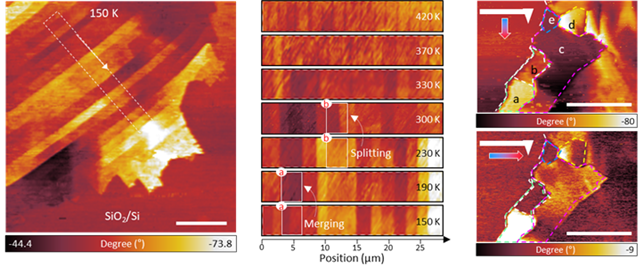- Prof. Young Hee Lee’s Research Team
- Successfully Materialized Ferromagnetic Semiconductors at Room Temperature
- The team synthesized two-dimensional (2D)monolayer Tungsten Diselenide (WSe2)
via vanadium dopant and reported theroom-temperature ferromagnetism.
 [Image 1] Professor Young Hee LEE and Researcher Seok Joon YUN
[Image 1] Professor Young Hee LEE and Researcher Seok Joon YUN
Diluted magnetic semiconductors, the semiconductors doped with impure magnetic elements, have been expected to play an important role in spintronics. They can control both charge and spin simultaneously, so ultra-fast, low power, and high density spintronics seems feasible.
Nevertheless, despite half a century of research, the issue of the Curie temperature (the minimum temperature at which the spins are aligned and ferromagnetic) being below room temperature and the uneven substance composition remained unsolved. If these two matters were not solved, commercialization of spintronics using magnetic semiconductors may have remained difficult.
Recently, the Center for Integrated Nanostructure Physics (Researcher Seok Joon Yun, Researcher Duong Dinh Loc, Professor Young Hee Lee) located in the Institute for Basic Science (IBS) under the Ministry of Science, ICT and Future Planning, succeeded in resolving the problem.
Using chemical vapor deposition, the research team synthesized vanadium-doped monolayer 2D Tungsten Diselenide (V-doped Wse2) and clearly saw that the Curie temperature is accessible above room temperature.

[Image 2] The Schematic for the synthesis of V-doped monolayer WSe2 by mixing liquid W with V precursors via chemical vapor deposition (CVD).
Meanwhile, the team observed the magnetic domain of monolayer V-doped Wse2 and the fact that the V-doped WSe2 reveals a Curie temperature above room temperature by analyzing the transition of the magnetic domain according to temperature and magnetization direction. It could be possible with the magnetic force microscopy (MFM), which is sensitive and can detect very small magnetic dipole moments within a nanometer.
Also, through the analysis of the atomic structure by transmission electron microscopy, it was revealed that vanadium is doped and distributed evenly on WSe2 which also resolved the old problem of uneven element status. Furthermore, it was revealed that the electron density could be altered and the ferromagnetic moment could be controlled.
Diluted ferromagnetic semiconductors at room temperature produced by the research team made wafer-sized synthesis possible. Due to this reason, it is expected to be commercialized as soon as possible.
Director Young Hee Lee, who led this research, said, “The research proved that ferromagnetic semiconductors at room temperature can exist within a thin material at the level of a monolayer, which hadn’t been discovered for the past half a century. Through the outcome of this research, we expect to bring about a breakthrough in the application of spin electronics and quantum computers.”

[Image 3] Photos of monolayer V-doped WSe2, depending on temperature and magnetic direction of a magnetic probe taken by magnetic microscopy
The outcomes of this were published on March 11th in Advanced Science (IF 15.804), a world-renowned scientific journal.















